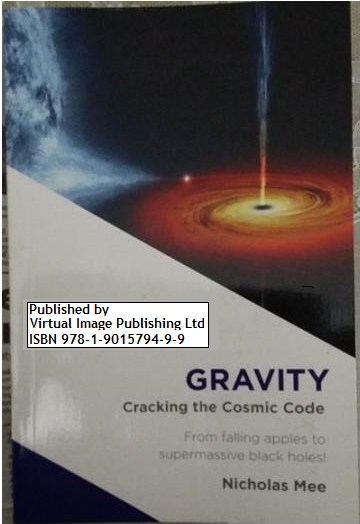Coming to grips with gravity may be the way to understand the forces and the matter in the universe, says S.Ananthanarayanan.
Detection of gravity waves and the Nobel prize for the pioneers has brought the focus on Albert Einstein’s formulation of gravity as a geometric effect that masses have on the structure of space itself. The force of gravity, however, is manifested at the level of planets, stars and the universe and can hardly be made out between objects of normal experience.
On the surface of the earth, of course, our planet exerts a force on each of us, which we believe we feel. Theoretical physicist and author, Nicholas Mee, however, in his book, Gravity – Cracking the cosmic code, argues that none of us has ever felt the force of gravity – for one is weightless during free fall under gravity. What we feel, as our weight, is the reaction of our bones and muscles, to the resistance that the ground we stand upon exerts to hold us where we are.

With this encouraging start, that we do not feel gravity, Nicholas Mee takes his readers through a rapid, 360 page, guided tour of centuries of contemplation in physics, mathematics, astronomy, art and symmetry, the cosmos and its origin – from the Greeks to Galileo, Copernicus, Tycho Brahe and Kepler, to Newton, and then to Einstein and the moderns, on to Stephen Hawking and those that followed. The narration brings characters into the story in sequence, as they introduce, or morph into succeeding roles, along the progress from primitive wonder in the presence of the night sky to the present-day comprehension of how the universe has evolved.

The book starts with an account of the Greek geometers and philosophers who described the first cosmologies. The circle was the perfect shape and the motion of the heavens was naturally described in circles. In keeping with religious beliefs, which assumed divine sanction to these early notions, the first astronomers devised complex mechanisms, based on circles, and faithful to God’s earth being the centre of the universe, to predict tides and the seasons and to explain the movements of the planets.
Apart from sallies into varied and esoteric areas of science, math and art, which relate to the physics of the universe, every chapter in the book starts with a quote from Shakespeare, Milton, Lewis Caroll, Star Trek or a poet or philosopher which sums up the chapter in comic seriousness. And the chapters teem with anecdotes about scientists and simple exercises which keep up the newcomer’s confidence and elucidate the subject matter.
Astronomers finally discarded the notion of a fixed earth and recognised the sun as the centre of the Solar System. And then, the advent of the telescope brought into view things in the night sky that had never been seen before. Other planets were seen to have satellites and new planets were discovered. By sighting stars from different locations, when the earth had changed position from one side of the sun to the other, the stars were seen as not fixed in a shell around the planets, but at great distances. The universe, in a sense, began to expand!
The orbits of planets were found to be not real circles, but ellipses, planets were found to go faster when nearer their host, and the idea grew of an attractive force that grew weaker by the square of the distance. Nicholas Mee, in his book, systematically builds the run-up to Isaac Newton and his monumental contribution, to mathematics, the laws of dynamics and the law of gravitation, which drove the clockwork precision of the solar system, asteroids and comets.
Newton’s formulation of gravity explained the motion of the planets with great accuracy. It was known that, the axes of spinning objects would go around in circles, like the motion of a spinning top. As planets had spin, these movements were observed in the planets too. In the case of Mercury, the innermost of the planets in the Solar System, however, the speed with which the axis of the planet’s spin went around did not agree with what was worked out. This was a long-standing mystery, and one explanation attempted was there was another planet, Vulcan, yet to be discovered, whose presence led to this effect on Mercury.
Enter, Einstein
Albert Einstein enters when electricity and magnetism have been understood and elegantly described by James Clerk Maxwell. There was, however, a question of what it was that filled space, even where there was a vacuum, that electromagnetic waves, of which visible light was a form, could traverse. If there was an ‘ether’, the medium of light, then, the speed of light should vary in different directions on the earth, for the earth moved through the ether at 30 km a second. The problem arose when experiment showed that the speed of light was the same in all directions.
As Maxwell’s equations gave the speed of light with no reference to the speed of a source, Einstein reasoned that discrepancies in the way speeds added up must arise from the way we regard distance and time. In the Special Theory of relativity, so called because it ignores gravitational effects, it is length and time that depend on the relative motion of an object and its observer, and the physical laws work equally for both, so long as one is in uniform motion with respect to the other.
Hence, moving clocks run slower and measuring rods shrink when they move. And then, the mass of a moving body increases with the speed, and mass and energy are equivalent. And as energy used to propel a body gets used up in the increase in mass, no object can move at the speed of light.
Now, mass is the bedrock of the older mechanics, where a heavier body needs a stronger force to set it moving. If heavy and light bodies fall to the ground with the same speed, it is because the heavier body is attracted to the earth with the greater force required to set it moving. Einstein saw something not so clear in this. Could it be just coincidence that the force of gravity on a body was the same as the force needed to set it in motion? Or was there some principle of the universe that was involved?
With perseverance and abstract mathematics, Einstein arrived at a formulation of gravity as an effect that the presence of a mass has on the shape of space, which is the reason for the attraction of masses, rather than a mysterious ‘action at a distance’, imagined by Newton. And with this formulation, Einstein showed that in the strong gravity felt by Mercury, there was a deviation from Newtonian mechanics and the difference in the speed of rotation of the axis of spin.
Sub-atomic world
The special theory of relativity has also profoundly affected understanding of the working of the sub-atomic world. At this scale, particles behave like waves and energy and mass are routinely transformed from one to the other. As the particles are small, however, gravitational effects are irrelevant.
Nicholas Mee, the author of the book, leads readers through the maze of ideas used to understand the sub-atomic world. If the first cosmologies were geometric and Einstein saw gravity as a geometric effect that mass had on space, the theories of the elements of matter are built around symmetries and topologies. Nicholas Mee guides the reader through the different concepts that result in the Standard Model, an extremely successful description of the sub-atomic world, but one that ignores gravity. One important idea is that while the elementary particles of nature, like photons or electrons, are either components of matter or carriers of forces, theories, like Stephen Hawking’s String Theory, that attempt to blend electromagnetism, the forces found in atoms and the force of gravity, propose ‘supersymmetry’, where force carrying particles have corresponding matter particles, and vice versa.
Experiments such as the Large Hadron Collider, at CERN, aim to create the high energies needed for these heavy, supersymmetric partners to appear. Nicholas Mee explains that the energies required are even higher than the capacity of the LHC. Gravity becomes a relevant effect only at the exceedingly small scale, smaller even than the particles in the nuclei of atoms. A theory of matter that can account for gravity would need to be tested at this scale, which implies very high energies.
The confirmation gravity waves exist holds out the hope of conducting gravity wave astronomy, which would investigate the very ancient and very high energy universe. This, possibly, would help resolve what is outside the capacity of man-made particle accelerators.
------------------------------------------------------------------------------------------ Do respond to : response@simplescience.in